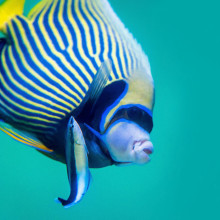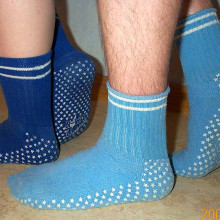In this NewsFlash, we find out why light makes migraines more painful, how cleaner fish keep each other in check and why special socks can help with bloodflow...
In this episode

00:11 - Why Light Makes Migraines Worse...
Why Light Makes Migraines Worse...
Scientists have discovered why light makes migraines worse, and the key to the breakthrough was the observation that some blind people also get relief by retreating to somewhere dark.
Rodrigo Noseda and his colleagues at the Beth Israel Deaconess Medical Centre in the US began by asking 20 blind people with migraines whether they experienced light-sensitivity or photophobia when they had headaches.
Surprisingly, some of them did and these were individuals who had sight-loss conditions like retinitis pigmentosa where the light-sensitive rods and cones degenerate, causing visual loss, but the rest of the retina remains healthy. On the other hand, people who were blind owing to congenital absence of their eyes or destruction or removal of the eyes didn't show this light sensitivity.
This suggested to the researchers that signals arising from the retina must be responsible. To find out how, they used dyes injected into rats to label the nerve cells that connect the retina to the rest of the brain.
They found a group of cells that connect to a region called the posterior thalamus. These nerve cells don't carry visual information but instead arise from a special group of retinal cells used by the brain to tell when it is like or dark in order to set the body clock.
But, the team found, the cells in the thalamus to which these nerves were connecting were also activated by pain nerves supplying the meninges, the layers that surround the brain and spinal cord and which are thought to become irritated during migraines and infections like meningitis.
So, by activating the same brain cells as the pain pathway, the light-signalling nerves boost the perception of pain.
Clinically, say the scientists, who have published the work in the journal Nature Neuroscience, this sets the stage for identifying new ways to block the pathway responsible, making migraines slightly less of a headache to endure...

02:52 - Keeping Cleaner Fish in Check
Keeping Cleaner Fish in Check
Have you ever caught someone just before they say something embarrassing? Did you give them a playful elbow? Well, it turns out that cleaner fish do something quite similar...
Cleaner fish are the little hangers-on you see on larger fish. And their name is self-explanatory, they clean the larger fish of parasites and dead skin cells. This 'dirt' is the cleaner fish's food and it keeps the host fish happy, or at least prevents them from eating their followers.
Now Nicola Raihani and her team have found that male cleaner fish will punish the female cleaners if they step over the line and start munching on the tastier host fish, instead. Because the host fish has a much more nutrient-rich mucus on their skin, and cleaner fish would much rather eat that. But this risks offending the host fish, which might mean the cleaner fish lose their food supply altogether.
In the journal Science this week they tested this by offering the cleaner fish some fish flake feed and some more extravagant prawns. They trained the cleaner fish so that, if one took a bite from the prawns, all the food would be removed from the tank. Very quickly, the researchers saw that whenever a female cleaner took a bite from the prawns the males would punish her by chasing her away. And afterwards the females were much less likely to give into their prawny temptation again.
I'm not sure what it says about male-female relationships. I know I get a telling-off if I reach for the chocolate. Perhaps I'm offending the god of good female figures? Raihani said "the males are less well behaved than the females a lot of the time but perhaps part of the reason the males are so likely to cheat is that females never punish males,"
But it might tell us something about the evolution of human behaviour and how we came to monitor each other's behaviour for an overall benefit to the society. Raihani suggests that, as the male fish are essentially looking after their own stomachs first, this is how behaviour which benefits the group as a whole might have evolved.

Repairing Aldehyde Dehydrogenase 2 - ALDH2
Scientists have found a way to repair the activity of a defective enzyme that prevents some people breaking down alcohol and which may also hold the key to preventing heart attacks and Alzheimer's disease.
Up to 1 billion people worldwide, including 40% of east Asians, carry an altered form of a gene coding for an enzyme called aldehyde dehydrogenase 2 or ALDH2 for short.  This breaks down a chemical called acetaldehyde, which is one of the substances produced when alcohol is metabolised by the liver.
This breaks down a chemical called acetaldehyde, which is one of the substances produced when alcohol is metabolised by the liver.
Shortly after consuming alcohol, individuals with the defective form of this enzyme develop symptoms of facial flushing, a rapid heartbeat and nausea, owing to the accumulation of acetaldehyde in the bloodstream. These individuals also have an increased the risk of oesophageal cancer, Alzheimer's disease and having a worse outcome from a heart attack.
Indeed, higher levels of this enzyme in heart muscle are strongly protective against heart damage and, whilst studying this, scientists recently found a drug molecule called Alda-1 that seems to be able to boost the activity of the healthy form of the enzyme and also to repair the defective enzyme; but they didn't know how it was working.
Now, writing in the journal Nature Structural and Molecular Biology, scientists at Indiana University and Stanford University, led by researcher Thomas Hurley, have found out how it works, which could lead to a whole raft of new treatments.
The team have worked out the three-dimensional structure of the enzyme, at the core of which is a tunnel-like structure that breaks down molecules like acetaldehyde. But in the defective form of the enzyme this tunnel is the wrong shape, so the enzyme cannot function.
But when the Alda-1 drug molecule locks on, which occurs on a different part of the enzyme, it bends the enzyme, prising the tunnel open so that it becomes active again.
Now that scientists have discovered how the Alda-1 drug works, it should be possible to find other molecules capable of doing the job even better and with the potential to impact on many different diseases, including reducing the damage done by heart attacks.

Nothing like a good pair of nitric oxide socks
During these cold winter months you might like to strap yourself into some lovely fluffy socks, perhaps that your granny made you at Christmas. And now you can get special socks for donor organs and people with diabetes, according to a paper from Chemistry of Materials this week.
 It's not quite putting livers in jumpers and hepatic veins in booties but chemists this week have described how they've created a special fabric that can deliver nitric oxide to donor organs.
It's not quite putting livers in jumpers and hepatic veins in booties but chemists this week have described how they've created a special fabric that can deliver nitric oxide to donor organs.
Nitric oxide is great in preventing damage to organs which aren't getting enough oxygen. It's actually a molecule which many animal cells use to communicate with other cells. And one of the tasks nitric oxide performs is as a muscle relaxant, which means it can dilate blood vessels and increase blood flow. Actually, it's one of the signalling pathways that Viagra capitalises on.
So this fabric contains zeolites which are molecular cages of aluminium and silicon oxides. And those cages will soak up gas molecules like nitric oxide and then release them in a controlled manner. The way they make the bandage fabric is to construct a water-repellant polymer, then embed some of these zeolites in it. They can control how fast nitric oxide is released by making the polymer more or less water repellent. So to get the nitric oxide flowing you just need to add moisture.
And the scientists working on this, Kenneth Balkus and Harvey Liu at the University of Texas, are solving a problem here that many have struggled with before in medicine. It's quite tricky to find reliable ways of storing and then delivering nitric oxide in a controlled manner. Because, as with many good things, too much is toxic.
So apart from wrapping donated organs ready for transplantation, the zeolite fabric could be used for people with diabetes, in whom it's been found that nitric oxide production is compromised. Wearing this fabric might increase blood flow in all sorts of extremities, and they could really benefit from some NO socks.










Comments
Add a comment